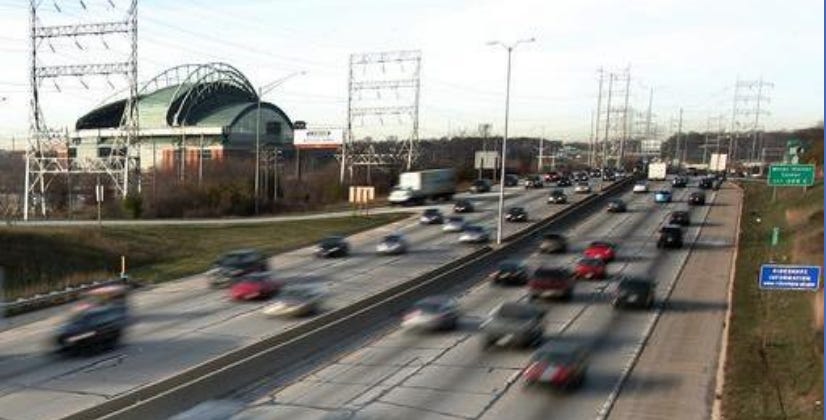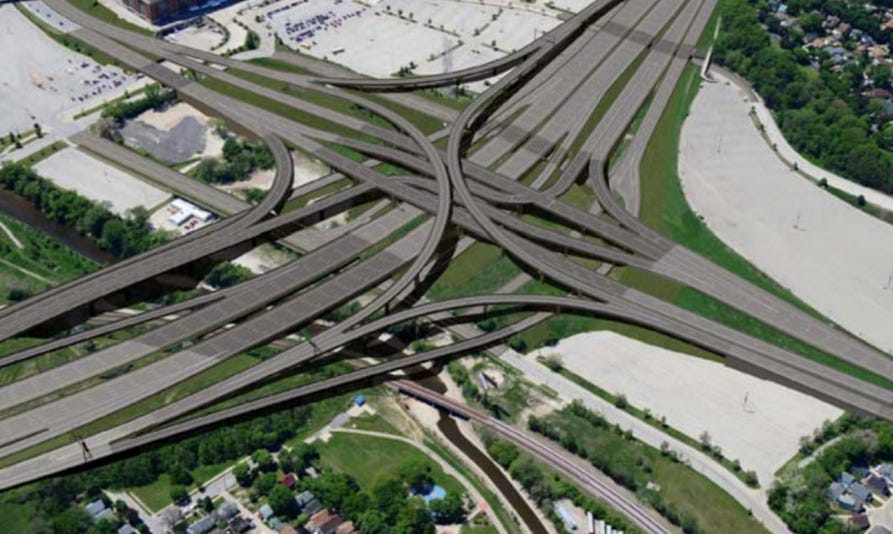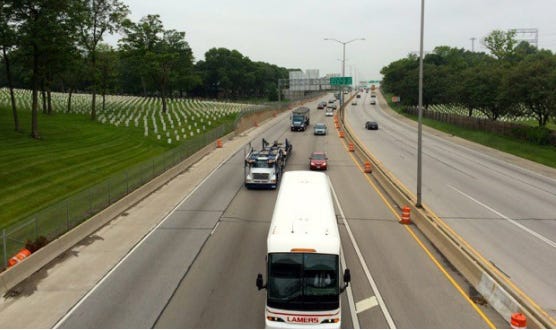Costs Rise for I-94 East-West Project, Estimate for Six-Lane Option Grows by Over 40%
WisDOT’s estimates for the billion-dollar highway reconstruction proposal in Milwaukee are on the rise, with costs for a six-lane option now being considered growing more than $250 million.
The Recombobulation Area is an award-winning weekly opinion column written by veteran Milwaukee journalist Dan Shafer. Learn more about it here.

Estimated costs for the I-94 East-West project are rising, according to Wisconsin Department of Transportation (WisDOT) documents, with the projected cost for a six-lane option growing by hundreds of millions of dollars.
The new estimate shows a $1.2 billion cost for the project’s six-lane modernization option.
Earlier this year, in an interview with The Recombobulation Area, WisDOT Secretary Craig Thompson said a modernization-only option for the proposed I-94 project without additional lanes would “be about $800 million to $850 million.” This new estimate is a more than 40% increase in cost from that previous figure.
The cost estimate for the proposal to add new lanes to the highway, however, does not have a similar increase. WisDOT documents show a $1.28 billion estimate for the eight-lane option. Past estimates have put the cost of the project at about $1.1 billion.
These estimates come as WisDOT presents new options to the public for the first time this year, with public involvement meetings on the project happening Dec. 8 (at State Fair Park, Tommy Thompson Youth Center) and 9 (at WDNR Milwaukee Office), both from 4 p.m. to 7 p.m.
WisDOT’s primary proposal for the East-West Corridor of I-94 in Milwaukee throughout this process has been for a widening of the 3.5-mile stretch of highway between 16th Street and 70th Street in the city of Milwaukee, with an additional lane in either direction to make it an eight-lane highway. Along with this would be a significant expansion of the Stadium Interchange where the interstate meets Wisconsin State Highway 175 near American Family Field on the city’s west side. A secondary option with the highway remaining at six lanes is now being considered.

The widening and expansion proposal was revived by Democratic Gov. Tony Evers in 2020 and advanced by the Republican-controlled Wisconsin State Legislature in the new state budget earlier this year.
Several groups – including a variety of civil rights organizations, faith groups, environmental organizations, transit groups, and others – have opposed this proposed highway expansion. We took an in-depth look at that opposition effort here as part of our “Expanding the Divide” series on the proposed expansion of I-94 in Milwaukee (see that full series here).
Many of those opposition groups, through the Coalition for More Responsible Transportation, instead have advocated for a reconstruction of the highway in its existing six-lane footprint. They released a plan called “Fix at Six” that, in addition to the repair and modernization of the highway, would include a new east-west Bus Rapid Transit line and plans to convert Wisconsin Highway 175 – the Stadium Freeway – to a boulevard.
The “Fix At Six” alternative proposal was released in September. That came after WisDOT’s April announcement of this year that it would be doing a Supplemental Environmental Impact Statement (SEIS), delaying the project, but allowing for additional study and public input.
Thompson told The Recombobulation Area that WisDOT and the Evers’ administration would be committed to a robust public engagement process on the I-94 project over the next year.
The Recombobulation Area reported in late November that WisDOT has updated a timeline on the overall project, with freeway construction projected to begin in 2025, and that a six-lane reconstruction option is now being considered.
These new WisDOT documents, presumably to be featured in this week’s public meetings, detail the rapidly shrinking cost difference between the two options. Part of why costs are similar, it says, is that the additional pavement for the eight-lane option would only be a “modest increase” from the six-lane option.
This would in part be due to the size of shoulders on the west leg of the project, as the department has said it is committed to not relocating graves in a cemetery adjacent to the highway (though a narrow section of the freeway would go through the cemetery area in the latest proposal), which was a topic of much dispute in prior incarnations of the project under former governor Scott Walker’s administration.

An eight-lane option, then, would have narrower lanes at this point of the highway, and the six-lane option would have more traditionally-sized lanes with shoulders. The total footprint of WisDOT’s six-lane option is estimated to be about 215 acres, and the eight-lane option is estimated at about 223 acres, according to the new documents. Also noted is that utility impacts and relocations are “very similar” for each option.
Not noted is whether or not a smaller Stadium Interchange would impact overall costs. Opposition groups’ proposal to convert the Stadium Freeway spur north of the interstate to a boulevard is also not addressed in WisDOT documents.
Additionally, there are two six-lane options included in new documents, one with a full interchange at Hawley Road and another with a half interchange at Hawley, with on/off ramps only on the west side of the interchange.
When we interviewed Thompson in April, $800 million for the six-lane option was a higher number than what we’d expected to hear.
State Rep. Daniel Riemer, a Democrat who is opposed to the expansion and whose district includes much of the project, said in a previous interview with The Recombobulation Area that WisDOT officials shared with him an estimate “in the $500 million to $700 million range” for the six-lane option. That was before the announcement of the new SEIS.
WisDOT’s updated timeline for this effort includes identifying a preferred option - i.e. six or eight lanes – by mid-2022.
To have your say on the project, there is an online form where you can provide comments here.
“We want to hear from you,” WisDOT says on its website. “This online comment form is a convenient way for you to provide input directly to the project team.”
Dan Shafer is a journalist from Milwaukee who writes and publishes the award-winning column, The Recombobulation Area. He previously worked at Seattle Magazine, Seattle Business Magazine, the Milwaukee Business Journal, Milwaukee Magazine, and BizTimes Milwaukee. He’s also written for The Daily Beast, WisPolitics, and Milwaukee Record. He’s on Twitter at @DanRShafer.
Subscribe to The Recombobulation Area newsletter here and follow us on Facebook at @therecombobulationarea.
Follow Dan Shafer on Twitter at @DanRShafer.




Since they have not proven 8 lanes are necessary and that by the principle of induced traffic, 8 lanes would not solve the problem they have, and given that 6 lanes would not save money, I think the solution would be to go to 4 lanes, to save taxpayer money and reduce the size of an unnecessarily wide highway. Further, if changed to a toll road, the demand would decrease so that 4 lanes would suffice, and the revenue from the tolls would support transit. Problem solved! #FixAtFour